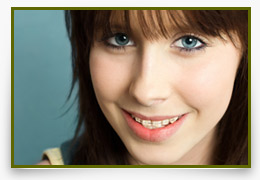Life with Braces
Life with Braces | Lip Bumper | Retainer Instructions | Head Gear | Emergency Care | Patient Care Videos | Palatal Expander

Prescription for Successful Orthodontic Treatment
Now that you are wearing cemented appliances (braces), there are several things you should know. If it pertains to you, please read this letter aloud with your parents and ask them to explain anything you do not understand.
The braces you are wearing will allow us to move your teeth so that they will look better and work (chew) more effectively, but, they need to be cared for so they will do their job in the quickest and most pleasant way. If you will follow these rules faithfully, you will be helping to speed up your treatment and improve the final result.
- GUM CHEWING Please refrain. This may pull the brackets off and slow down treatment. This rule pertains to all other gooey and sticky treats or foods such as taffy, Now and Laters and Sugar Daddys.
- NO HARD FOODS If you would like to enjoy raw carrots, etc, please cut them into thin sticks. If you must have ice in your mouth, use small chips, not cubes. Cut meat from bones so as not to pop brackets off when biting into ribs and such. Never open nuts with your teeth - NEVER!
- BRUSH, FLOSS, FLUORIDE EVERYDAY You should brush after every meal and snack and before you go to bed (about 4-5 times per day). You should floss once a day. You may use any over the counter fluoride rinse after your last brushing of the day before you go to bed.
- IF BRACES BREAK OR BECOME LOOSE, PLEASE CALL US AT ONCE. Although this is not and emergency unless you are in pain, we may want you to reserve more time for you at your next appointment.
- WEAR YOUR ELASTICS ALL THE TIME! If asked to wear elastics, wear them all the time even during meals and change them every 24 hours. If you are having any difficulty placing the elastics properly, call us immediately for an appointment so you don't lose progress. Should you run out of or lose your elastics, come in at once for a new supply, or call us to mail you new ones.
- Soup
- Pasta (spaghetti, lasagna, macaroni & cheese)
- Eggs (omelet, scrambled, Quiche)
- Cheese (hard & soft, cottage cheese, blitzes, cheese cubes)
- Yogurt, Rice, Potatoes, Salad (tuna, salmon, egg)
- Pudding
- Jello
- Pancakes
- French Toast
- Milk Shakes
- Fish
- Cooked Vegetables
- Canned or Soft Fruit
- Peanut Butter
- Pot Pies
- Cereals (cold oatmeal)
- Soft Meats and Poultry
- Select a soft or extra-soft tooth brush
- Use a toothpaste containing Fluoride
- Plan to spend at least TWO to FIVE (2-5) minutes brushing
- Plan to brush AT LEAST FOUR or FIVE Plus (4 or 5+) times per day—after ALL meals and snacks and before bed.
- Brush your lower gums from one side all the way to the other side
- Angle the brush up from below the lower brackets, (braces), and brush the bottom of each and every brace
- Face the toothbrush against the "outside" surface of the braces and brush each individual bracket in a circular motion.
- Angle the brush down from above the braces and brush the top of each bracket
- Now brush the biting surfaces of your teeth from one side all the way to the other, and remember, there may be more teeth than braces in your mouth, so don't forget to go all the way back
- Brush the lingual aspect, (tongue side), of the teeth
- Repeat this process for the upper teeth!
- Brush the roof of your mouth and your tongue
- Rinse vigorously
- Look in the mirror and check to see if there is any food, plaque or debris in, on or around the braces and/or your teeth; and if there is, then brush those areas again
- Brushing Instructions
-

Brushing: Step 1
Place your toothbrush at a 45 degree angle to your gum.

Brushing: Step 2
Brush gently in a circular motion.

Brushing: Step 3
Brush the outer, inner, and chewing surfaces of each tooth.

Brushing: Step 4
Use the tip of your brush for the inner surface of your front teeth.
- Flossing Instructions
-

Flossing: Step 1
Wind about 18 inches of floss around your fingers as shown. Most of it should be wrapped around one finger, and as the floss is used, the other finger takes it up.

Flossing: Step 2
Use your thumbs and forefingers to guide about one inch of floss between your teeth.

Flossing: Step 3
Holding the floss tightly, gently saw the floss between your teeth. Then curve the floss into a C-shape against one tooth and gently slide it beneath your gums.

Flossing: Step 4
Slide the floss up and down, repeating for each tooth.
Please remember these 5 rules. You may be asked to repeat them when you come in.
Patients are often uncomfortable for up to 2 weeks after having braces put on their teeth. If this occurs during the day time, we recommend ADVIL, Tylenol, or whatever you would take for minor to moderate headache. For night time comfort, we have given you a prescription for a more powerful medication, which may cause drowsiness. It is not necessary to take this if you can tolerate the changes in your mouth.
It is important to maintain a sound diet during treatment. The following is a list of suggested foods that are soft and easy to eat:
Soreness caused from braces and appliances
When you first get your braces, you may notice that your teeth and mouth feel a little tender or sore. This is perfectly normal for patients who have just gotten their braces put on, and we promise your mouth will not be sore forever! To relieve the pain, we recommend dissolving one teaspoon of salt in eight ounces of lukewarm water. Swish and gargle this solution in your mouth for just a couple of minutes (do not swallow the saltwater).
If the pain is more severe and does not go away after rinsing, you can also try taking a pain reliever. It is also not uncommon for your lips, cheeks, and tongue to become irritated for one to two weeks as they toughen and become used to the braces. We would be happy to give you some wax that you can put over the braces to lessen the tenderness. If you need some wax, please let us know!
Loose Teeth
If your teeth begin feeling a little loose, don’t worry; this is normal! Your braces must first loosen your teeth in order to move them into the right position. Once your teeth have been repositioned, they will no longer be loose.
Loose Wires and Bands
The wires and bands on your braces may come loose. If this happens, please contact us as soon as possible so that we can check and repair your appliance. If any piece of your appliance comes off, be sure to save it and bring it to the office with you.
You can temporarily fix the loose wire by using the back of a spoon or the eraser end of a pencil to carefully and gently push the wire back into place. If the loose wire is causing irritation to your lips or cheeks, put wax or a wet cotton ball over the broken wire to relieve the pain.
Take Care of your Appliances
Damaged appliances can increase the length of your treatment process, so be sure to take care of all your appliances. Your teeth and jaw can only move into their correct positions if you consistently wear the rubber bands, headgear, retainer, or other appliances prescribed by your doctor.
Click here to read more about the proper care of your appliances
Playing Sports with Braces
Game, Set, Match – we have great news for athletes! You can still play sports even while undergoing orthodontic treatment! If you do play sports, it’s recommended that you wear a mouthguard in order to protect your teeth and your appliance. Let your doctor know if you need help finding the right mouthguard for the best protection.
In case of a sports emergency, be sure to immediately check your mouth and your appliance for any damage that may have occurred. If you notice any loose teeth, or if your appliance has been damaged, please contact our office right away. You can temporarily relieve the discomfort with wax or by rinsing your mouth with warm saltwater.
Brushing Your Teeth with Braces
When you have braces it’s very important to brush and floss after every meal in order to keep your teeth and gums healthy throughout your treatment. If you need help choosing the right toothbrush, toothpaste, and dental floss, please ask us and we can help you choose the right products for your teeth and your appliance.
Brushing your teeth is the single most important thing you can do to enhance your orthodontic experience. If done correctly, you will be much more comfortable throughout your entire treatment. Proper brushing technique will help to prevent gingivitis, bleeding of the gums, periodontitis, (gum and bone disease), decalcification, (irreversible white stains on teeth), and cavities.
Some tips before you begin:
Bacteria can live on every surface in your mouth, including your orthodontic appliances. Here is the most effective technique to ensure you maintain proper dental/orthodontic health during your treatment: (for this example, I chose to start on the lower, however, you may start on the upper)
Flossing with Braces
Flossing while you have braces is incredibly important in the hygiene process. While it is significantly more time consuming than without braces, at first, once the correct technique is learned, it isn't much more difficult than without braces.
We recommend superfloss for flossing due to its superior design and ease of use. Superflosshas three sections per strand. There is a firm end, a "fuzzy" section and a standard floss section. The firm end allows you to easily thread the strand between the wire and the teeth. Once the floss is laced here, it is very easy to gently guide it back and forth between the contacts of the teeth and above or below the gum line with the standard floss section. Once you have flossed both teeth in one area, you must rethread the floss between the next set of adjacent teeth. The soft and "fuzzy" section is useful for grabbing plaque that is hiding behind the small crevices around the braces.
You should floss your teeth at least once per day for effective home care.
REMEMBER TO SEE YOUR DENTIST AND HYGIENIST FOR REGULAR CLEANINGS AND CHECK-UPS THROUGHOUT YOUR TREATMENT!!!!



